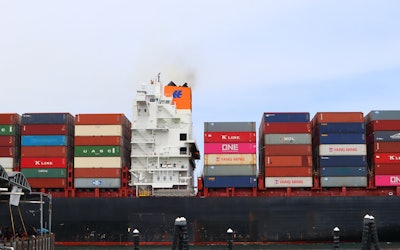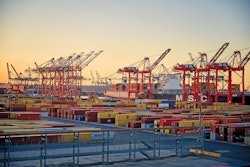
When it comes to U.S. ports and ocean carriers, it’s safe to say that for a sector traditionally stagnant, it’s experienced a great deal of change over the past couple of years.
From dockworker strikes and heightened adoption of nearshoring to an uptick in fuel charges, a deteriorated infrastructure and economic uncertainty with regards to increased tariffs, the ripple effect has been – and will continue to be -- felt across all ports nationwide.
But what does this all mean for 2025? And what will the State of Ports and Ocean Carriers look like in the New Year?
Food Logistics talks exclusively with Tom Perrone, SVP of global professional services at project44, about the push for reshoring, an increased focus on sustainability and the role the “3-degree shift" will play in cold food chains.
CLICK HERE to read the full article.
Food Logistics: The global container shipping industry continues to witness an increase in freight demand for U.S.-bound shipments. What does this mean? And what will this look like come 2025?
Tom Perrone: As 60 countries held elections in 2024 and 64% of voters expressed dissatisfaction with the current economic situation in their country, the year was characterized by uncertainty and change. Many businesses were cautious in their shipping strategy, waiting to see the outcome of elections – and, in many cases, pro-commerce groups gained traction. Assuming inflation and interest rates continue to decline, I anticipate demand will spike in the summer of 2025. With better weather and time to adjust to the new administration in the U.S., consumers will likely feel more settled and optimistic by the summer, spurring increased global shipping demand.
Food Logistics: From your vantage point, what are some of the top disruptions impacting ports and ocean carriers? And, why?
Perrone: Labor action is one of the top disruptions currently impacting ports, with most major U.S. ports experiencing recent strikes and the threat of future strikes looming. As a more pro-business administration takes office in the U.S., it could make labor relations more contentious. Canada also saw an uptick in labor action in 2024, with a major railroad strike and a peak-season strike by Canada Post workers that caused ripple effects across supply chains.
The second major barrier impacting ports is deterioration in infrastructure, which I expect will be felt in the next year or two. U.S. ports are lagging in infrastructure and technology, and if we don’t make investments in vessel capacity and technologies such as automation to keep these ports up to date, the problem will only get worse.
Food Logistics: What does Donald Trump’s re-election mean for the future of ports and ocean carriers., i.e., tariffs?
Perrone: President-elect Trump has promised a 25% tariff on inbound goods from Canada and Mexico, as well as increased border security. Border tightening would also mean greater scrutiny on the movement of illicit goods across the Mexican and Canadian borders. Currently, only a fraction of cargo shipped to the U.S. from Canada is actually checked, and our border crossings aren’t built for higher search volume. So, with increased border security, we could see a slowdown in transit time for goods flowing from Canada to the U.S. I also anticipate growing demand to manufacture goods locally will lead to an increase in industrialization in the U.S. That is, the production of machinery currently made offshore in China or India will be brought back to the U.S. Trump’s proposed 10% tariff on all goods imported from China is likely to have the heaviest impacts on electronics, textiles/apparel and machinery. Overall, the introduction of U.S. tariffs could provoke retaliatory measures from other countries that ultimately suppress global trade.
Food Logistics: The International Longshoremen’s Association (ILA) and the United States Maritime Alliance (USMX) reached a tentative agreement on wages, extending the Master Contract until Jan. 15, 2025. What does another possible port strike mean for U.S. supply chains?
Perrone: I expect the ILA will strike again in mid-January. Wages continue to be a concern, but the biggest sticking point for U.S. ports is automation – the ILA is against applying technology like automated cranes and scanners at U.S. ports. With the initial ILA strike in October, project44 data showed a 100% increase in vessel approach time and a 60% increase in export dwell time at Gulf and East Coast ports. Truckload on-time performance also fell to a low as carriers tried to absorb the influx of volume as the strike ended. Another strike would bring significant economic consequences and ripple effects across supply chains. Some shippers estimate that for every one week of an ILA strike, it will take 4-6 weeks to fully recover and could cost the economy up to $5 billion per day. Several industries, such as energy and petrochemicals, agriculture, retail, automotive and food and beverage, rely heavily on East and Gulf Coast ports and could be disproportionately impacted.
Food Logistics: Nearshoring is becoming a more common approach to supply chain optimization. What are some of the pros/cons of nearshoring? What does this mean for the state of imports and exports?
Perrone: I anticipate we’ll see a big push for reshoring with the new administration – which is where facilities and jobs are brought back to the U.S. (as opposed to nearshoring, where facilities may be built in neighboring countries like Mexico). We may see a revival in industries previously abandoned in North America – such as textiles, heavy equipment manufacturing and shipbuilding.
Pros of reshoring or nearshoring include greater control over supply chains and increased profit margins in the long term (even if building new infrastructure costs more in the short term). Another benefit of relocating production is that suppliers and retailers have more options when sourcing goods. For shipping, this means reduced lead times, lower emissions and greater resilience (i.e., fewer disruptions, geopolitical tensions, etc.). The cons of nearshoring or reshoring include the introduction of a new set of geopolitical risks, higher upfront costs and potential shortages of skilled labor (which could result in quality control issues).
Food Logistics: What technologies or features did your port/ocean carrier or your members implement/deploy to become more sustainable?
Perrone: We’re seeing increased focus on measuring sustainability – whether for regulatory reasons, public relations or internal commitments. project44 is supporting shippers in monitoring and reporting on shipment-level Scope 3 emissions. I also expect we’ll soon see technology from the military, like nuclear-powered ships with small modular reactors, applied to commercial shipping to reduce greenhouse gas emissions.
Food Logistics: What technologies or features did your port/ocean carrier or your members implement/deploy to become safer for workers?
Perrone: We’re seeing AI increasingly used for regulatory compliance – for example, monitoring the number of hours a driver spends behind the wheel of a truck or the speed of the vehicle to comply with safety regulations. Already, we’re seeing self-driving trucks start to increase road safety, and we may see a similar trajectory with autonomous ships.
Food Logistics: Please share any stats/market trends detailing the status of the ports and ocean carrier market as it stands end of 2024 heading into 2025.
Perrone: One of the biggest ocean trends we saw in 2024 was shippers hedging against the threat of tariffs and potential labor strikes by pulling freight forward. project44 data indicates U.S. imports from China rose nearly 7% in 2024, with an uptick starting in May, when the Biden administration announced tariffs on goods from China, through September when they took effect. With this shift, ocean peak season and holiday shopping started earlier than in years past.
Food Logistics: What are some things not addressed above that may be pertinent to our cold food chain readers?
Perrone: An underrated trend in cold food chains is the “3-degree shift.” For nearly 100 years, the standard for storing and transporting frozen food was set at -18 degrees Celsius. However, new research suggests that increasing this temperature by just three degrees to -15 degrees Celsius could reduce carbon emissions by 17.7 million metric tons per year, without compromising food safety or quality. project44 has joined several shippers in a pan-industry coalition called “The Move to -15” to explore how make this temperature shift a reality.
CLICK HERE to read the full article.

















